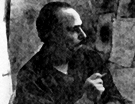 “I like to travel and I like to visit places that affect me….I’ve been told that it was wrong….It’s as if you have to do it justx here and [must] shut your eyes to other things. I don’t believe in shutting my eyes to anything….Art is art anywhere.”
“I like to travel and I like to visit places that affect me….I’ve been told that it was wrong….It’s as if you have to do it justx here and [must] shut your eyes to other things. I don’t believe in shutting my eyes to anything….Art is art anywhere.”
-Conrad Marca-Relli
Biography :
Known for his Cubist and Abstract Expressionist style of collages as well as paintings, Conrad Marca-Relli lived for most of his professional life in New York City but was an inveterate and enthusiastic world traveler.
He was born in Boston, Massachusetts on June 5, 1913 but because his father was a news commentator and journalist, he made many trips to Europe as a child. He began to draw at an early age and his parents encouraged him to the extent that he received his first art lessons in Italy. Upon returning to New York City, he completed his education at night in order to devote more time to painting.
In 1926, he settled in New York City where he studied at various schools including Cooper Union. From 1935 to 1938, he was a WPA artist with the Federal Art Project which gave him the time to devote his energy to developing and experimenting with his art. It also brought him into contact with other New York artists such as Willem de Kooning, Jackson Pollock, and Franz Kline. After his service in World War II, he returned to Europe to paint. These paintings were later exhibited in New York City at the Niveau Gallery.
Returning to New York, he continued with a style of controlled sharp edged shapes. On a trip to Mexico in 1953, he was impressed by the contrasts between the white adobe buildings and the black shadows from the luminous sun. Marca-Relli was completely consumed by this sight and, according to his mythology, when he ran out of paint, he began gluing material and paper in order to achieve a greater incisiveness of the borders. He immediately found that collage provided the density and texture he sought. These early collages were created from segments of either raw canvas or natural linen, cut out with razor blades. They were pinned to the supporting canvas after being coated with a mixture of paint and glue. Soon he introduced volumes of color to his work.
In 1958, Marca-Relli spent a few months in the south of France. While there, he translated his impression of the translucence of the Mediterranean light by contrasting one dominant hue with other strong colors.
By 1960, his collages were completely nonobjective. He had moved from the pliability of canvas to more resistant materials such as wood, metal and plastic, this gave his work an industrial appearance. He condensed his colors and forms to convey his belief in the duality of negative and positive forces.
Throughout the rest of his life, he remained committed to his personal journey, seeking to express to the world his creative voice in its ever-changing manifestations.
Conrad Marca-Relli died at 87 on August 31, 2000 in Parma, Italy.
